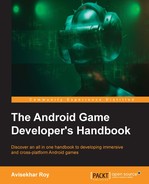Android game development was mainly limited to smartphones before Android tablets came into the picture. It was much more fun to play a game on a tablet. Tablet gaming became popular over a short period of time because of the following reasons:
- Bigger screen: Although a bigger screen with the same resolution compromises the visual quality, it provides bigger visibility. Bigger visibility enhances the art asset to reveal its details, which is not always possible for a small screen smartphone.
- Bigger physical size: Bigger physical size forces the player to play with both hands, which results in better grip on the device and better controls.
- Bigger space/playable area: Bigger playable area can provide more control space. That means that the player need not to be accurate while using the touch control system, so he/she can concentrate more on the game alone. Thus, it enhances the gaming experience.
- Less constraints: Continuous playing of games causes a serious amount of battery drainage. In case of phones, the primary objective is to stay connected with a network. So, keeping the device alive is very necessary. But a tablet does not have a particular goal. It is a multipurpose utility device. One of the purposes can be playing games. Therefore, there is no hardcore necessity to save power for jobs other than gaming.
- Less interruption: We all know how any interruption can be irritating during an ongoing job. The same goes for the gaming experience as well. Any interruption causes a major pause in gaming, and most of the time, players quit at that point in time. On a tablet, there are fewer chances of automated interruption than manual or physical interruption; this means less irritation while playing on a tablet.
For Android tablet game development, a developer should keep the following constraints and features in mind:
- Big display area
- Wide range of resolution, and comparatively low pixel density
- Full-screen multitouch interface
- Sensor support for gyro, accelerometer, compass, ambient light, and so on
- Wide range of RAM
- A wide range of processors and performance
- Fewer chances of interruption
Tablets evolved from the idea of a small portable computing device, which could be the bridge between smartphones and PCs/laptops.
A bigger screen always helps the user to interact with the game more easily. Game designers have more space to utilize. However, this slightly increases the headache for developers, as the visual quality has to be maintained within the same hardware limitation.
Previously, most tablets used mobile processors, but tablet manufacturers are using laptop processors for tablets now. Intel Atom is an example of this. The more capable the processor used in a device, the better the quality it can deliver.
There was a time when Android games were targeted for mobiles first, and then those were ported for tablets. But the table has turned now. Now there is a very thin line between the development of smartphone games and games for tablets. Most of the time, the same APK can support both phones and tablets with almost the same quality and performance. There is no more exclusive porting for tablets.
